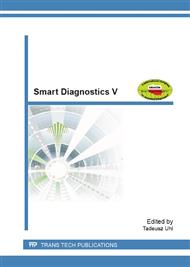[1]
S. Iijima, "Helical microtubules of graphitic carbon," Nature, vol. 354, (1991) no. 6348, p.56–58
DOI: 10.1038/354056a0
Google Scholar
[2]
R.H. Baughman, A.A Zakhidov and de Heer, W. A.: Carbon nanotubes – the route toward applications. Science, USA(2002)., 297:787-792
DOI: 10.1126/science.1060928
Google Scholar
[3]
B. Mahar, C. Laslau, R. Yip, and Y. Sun, "Development of carbon nanotube-based sensors - a review," IEEE Sensors Journal, Vol. 7, No. 2 (2007), pp.266-284
DOI: 10.1109/jsen.2006.886863
Google Scholar
[4]
T. Tombler,C. Shou, L. Alexeyev, J. Kong, H. Dai, L. Liu, C. S. Jayanthi, M.Tang and Wu S.-Y.:Reversible electromechanical characteristics of carbon nanotubes under local-probe manipulation. Nature, USA (2000), 405 (6788):769-72
DOI: 10.1038/35015519
Google Scholar
[5]
E.D Minot, Y. Yaish, V. Sazonova, J. Park, M. Brink and McEuen P. L.: Tuning Carbon Nanotube Band Gaps with Strain. Physical Review Letters, USA (2003) vol. 90, no. 15, p.156401/1–156401/4
DOI: 10.1103/physrevlett.90.156401
Google Scholar
[6]
V. Semet, V. T. Binh, D. Guillot,K. Teo, M.Chhowalla, G. A. J. Amaratunga, W. I. Milne, B. Legagneuxand D. Prilbat: Reversible electromechanical characteristics of individual multiwall carbon nanotubes. Applied Physical Letters, vol. 405 (2005), pp.769-92
DOI: 10.1063/1.2136229
Google Scholar
[7]
H. Lee; S. Lee,D-H. Kim,D. Perello,Y. J. Park,S.-H Hong, M. Yun, S. Kim; Integrating Metal-Oxide-Decorated CNT Networks with a CMOS, Readout in a Gas Sensor, Sensors (2012); 12(3): 2582–2597.
DOI: 10.3390/s120302582
Google Scholar
[8]
L. J. Loh, J. Kim and J.P. Lynch: Self-sensing and power harvesting carbon nanotube-composites based on piezoelectric polymers. University of Michigan, USA 2008.
Google Scholar
[9]
Chengguo Hu, and Shengshui Hu, Carbon Nanotube-Based Electrochemical Sensors: Principles and Applications in Biomedical Systems. Journal of Sensors, Volume 2009 (2009), Article ID 187615, 40 pages
DOI: 10.1155/2009/187615
Google Scholar
[10]
W. Zhang, J. Suhr, N. Koratkar: Carbon nanotube/polycarbonate composites as multifunctional strain sensors. Journal of Nanoscience and Nanotechnology, USA (2006) Apr;6(4):960-4.
DOI: 10.1166/jnn.2006.171
Google Scholar
[11]
Park, Myounggu; Kim, Hyonny; and Youngblood, Jeffrey, "Strain-dependent electrical resistance of multi-walled carbon nanotube/polymer composite films" (2008). Birck and NCN Publications. Paper 196.
DOI: 10.1088/0957-4484/19/05/055705
Google Scholar
[12]
I. Kang, M. Schulz, J. Kim, V. Shanov, and D. Shi: A carbon nanotube strain sensor for structural health monitoring. Smart Mater. and Struct., (2006), 15(3), 737
DOI: 10.1088/0964-1726/15/3/009
Google Scholar
[13]
S. M Vermuru,R Wahi, S. Nagarajaiah, Ajayan P M, Strain sensing using a multiwalled carbon nanotube film, Special issue paper 555, (2009)
DOI: 10.1243/03093247jsa535
Google Scholar
[14]
Y. Gang,H. Ning,K. Yoshifumi, L. Yaolu, L. Yuan, F. Hisao: A carbon nanotube/polymer strain sensor with linear and anti-symmetric piezoresistivity, Journal of composite materials, (2011) 45(12), pp.1315-1323
DOI: 10.1177/0021998310393296
Google Scholar


